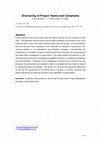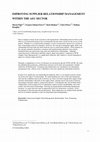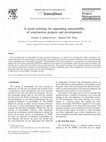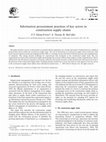Papers by francis edum-fotwe

Construction projects involve and generate a number of interfaces between the various parties as ... more Construction projects involve and generate a number of interfaces between the various parties as these come together to deliver the output. Projects are typically characterised by complexity and previous analyses have been conducted mainly from the technical perspective. Only recently the subject of complexity has been linked to non-technical project aspects such as behavioural, social, cultural and interconnections. This paper is set out to describe the initial findings from 31 interviews with construction Project Managers which were carried out as part of an extensive investigation into socio-organisation complexity and its characteristics as this is created by the interconnection structures. In addition to the interviews, a postal survey and five case studies have been carried out all focusing in the areas of selecting project team members, structuring the project team and the management style followed by the Project Managers. Results indicate that complexity although recognised ...
International Journal of Project Management, 2003
Facilities, 2008
Purpose – The purpose of this paper is to present an investigation of facilities management (FM) ... more Purpose – The purpose of this paper is to present an investigation of facilities management (FM) needs of warehouse tenants to inform future warehouse design. Design/methodology/approach – This study examines FM needs that must be designed into warehouse projects. It identifies tenants' FM requirements in warehouses; investigates the relationship between tenant satisfaction and performance of different facilities in warehouses; and

All project life cycles from the shortest to the longest demand from the project teams some type ... more All project life cycles from the shortest to the longest demand from the project teams some type of reporting.
Currently the construction industry perceives reporting as a bureaucratic contractual process that occurs as and when demanded by the Client or the Senior Manager. It does not contribute as much as it should to the decision making process and frequently the faster pace of the project makes the reporting process redundant. Reporting, as part of the written form of communication within the project system, is considered as the means of interconnecting the numerous activities that contribute towards the delivery of the project and the actors that are involved in the project. The interconnections or interrelations are established through the report writers (encoders) and the recipients of the reports (decoders) and these are affected by a number of factors. These factors and the number of interconnections introduce complexity.
In this paper the authors will review current literature in project reporting and will present examples of reporting features that contribute to project complexity. They will discuss some of the key reporting attributes under the context of complexity and will propose a conceptual approach to minimise complexity driven in projects through reports. Finally they will highlight the future challenge(s) that are faced by academia and the industry with regard to reports.
Keywords: communication, complexity, information management, project reporting

Project activities at the various levels within the delivery process have an influence on each ot... more Project activities at the various levels within the delivery process have an influence on each other. This generates interconnections and boundaries between the activities as well as the individuals within a team, and teams as whole entities, within the project. The interconnection structures often give rise to complexity, which could lead to a reduction in performance if the resulting interface is not purposefully and efficiently managed. Understanding the characteristics of complexity caused by interconnections and their effect on the performance will enable better management of project teams. The authors present the results of a multi-method study of construction organisations to highlight the effects of complexity generated by the interconnections. Complexity in the management of projects and in particular the sub-process of structuring teams are reviewed in order to investigate the level of actions required to manage the effects of complexity. The results from the study have significant implications for the way the sub-process of structuring teams in projects is currently conducted and present opportunity for achieving innovation in the organisation of project teams.
Keywords: Complexity, Interconnections, Structuring of Project teams, Project Management processes, Project performance
Interconnections and boundaries between the project parties have been identified as causing compl... more Interconnections and boundaries between the project parties have been identified as causing complexity which, if not managed, leads to reduction in performance. Understanding the characteristics of complexity of interconnections, and how these affect organising projects and the management style, will enable the development and implementation of innovative project actions and tools. The authors present results from a study of UK construction organisations on the influences of complexity generated by the interconnections. The results have significant implications on how project teams are put together and managed; they also enabled the development of a framework for managing complexity of interconnections in projects.
Keywords
Complexity, Projects, Organisation, Management Style

Technical complexity has always been considered a factor which affects project performance. Sched... more Technical complexity has always been considered a factor which affects project performance. Scheduling and other mechanisms have been proposed which allow for the management of these effects. However, the effect of the complexity of interconnections, and in particular those caused by social interfaces and boundaries between the various teams, have not been investigated. Socio-organo complexity is caused by interconnections which if not managed could lead to a reduction in performance. Understanding the characteristics of complexity of interconnections, how these affect project schedule performance and what deductions can be extracted, will enable the development and implementation of innovative actions and tools that will support the management of the effects of complexity through the respective processes. The authors present results of five case studies, with UK construction organisations, which demonstrate that the effects of socio-organo complexity of interconnections have similarities with the behaviour of underdamped control systems. The results from the study have significant implications for the way socio-organisational issues are managed but will also enable parallels to be drawn between the fields of project management and control systems.
Keywords
Complexity, Interconnections, Project Schedule Performance, Control Systems
Proceedings of the RICS COBRA 2010 Conference Held in Paris, Sep 5, 2010
World-class organisations demonstrate international competitiveness and a capacity to both match ... more World-class organisations demonstrate international competitiveness and a capacity to both match and surpass the performance of the best-in-class global organisations. These organisations are able to emulate, match or exceed industry and other global leaders in their outputs and business practices. World-class performance can be demonstrated through comparisons with both competitors and best-in-class organisations from other industries.

Due to changes in many facets of projects and organisations, relationships between firms in the d... more Due to changes in many facets of projects and organisations, relationships between firms in the delivery of construction projects have consequently become more critical for the success of the project. Whether it is a transactional exchange or series of transactions spread over a period of time, relationships need to be managed. However, the concept of managing supply chains and relationships between firms has been relatively new to construction industry. Early pioneers of the concept, primarily automotive, aerospace and manufacturing industries, have greatly benefitted from non-adversarial, long-term and collaborative relationships. Although contextual factors within those industries largely shape each industry’s approach to SCM (Supply Chain Management), it is application within the AEC industry is slowly beginning to appear in a distinct shape and form.
Through a comprehensive review of literature on construction-specific SCM (cSCM), the study has identified that partnering, collaboration and trust are the three most prominent variables within the cSCM literature. Partnering and collaboration are considered to be relationship management tools, whereas trust is identified as the most significant relationship facilitator.
In spite of its significance on relationship development, there is very limited research carried out on the trust aspect of relationships. By understanding how trust is built and maintained, and what the conditions that result in mistrust are, firms can better manage their supply chains and their relationships with firms in the supply chains, manage factors that result in mistrust and mitigate potential conflicts arising from mistrust. Consequently this will facilitate better collaboration, result in high-level of commitment, improve project teambuilding, and avoid conflict and adversarial relationships. Drawing on organisational relationship management literature, we argue that trust must be approached from five dimensions; economic, social, psychological, inter-personal and organisational. These dimensions are unidirectional and they must be accounted conjointly as they are interrelated and interdependent.
Journal of Performance of Constructed Facilities, 2003
... and installation for information systems) includes failure to meet the specified requirement,... more ... and installation for information systems) includes failure to meet the specified requirement, costoverrun, and time overrun, and more ... NHS Trust. ... what is generated from them, and how they influence construction costs become counterproductive from a total cost and functionality ...

Engineering, Construction and Architectural Management, 2004
ABSTRACT The concepts underlying innovation and standardisation presents an apparent divergence i... more ABSTRACT The concepts underlying innovation and standardisation presents an apparent divergence in what each strives to achieve. In the view of the authors, this has contributed in no small measure to the low take-up of standardisation within the construction sector as organisations strive to be innovative to improve on their performance and attain continuous improvement in their processes and operations as well as design solutions. The paper presents as a case, how one major public sector outfit is striving to achieve innovation within an agenda that involves a widespread adoption of standardisation. It presents the motivations for adopting an organisation-wide agenda on innovation and standardisation, identifies the elements of apparent incongruity between the concepts, and outlines how the case organisation has resolved the divergences.
Journal of Management in Engineering, 2009

International Journal of Project Management, 2011
Technical complexity has always been considered a factor which affects project performance. Sched... more Technical complexity has always been considered a factor which affects project performance. Scheduling and other mechanisms have been proposed which allow for the management of these effects. However, the effect of the complexity of interconnections, and in particular those caused by social interfaces and boundaries between the various teams, have not been investigated. Socio-organo complexity is caused by interconnections which if not managed could lead to a reduction in performance. Understanding the characteristics of complexity of interconnections, how these affect project schedule performance and what deductions can be extracted, will enable the development and implementation of innovative actions and tools that will support the management of the effects of complexity through the respective processes. The authors present results of five case studies, with UK construction organisations, which demonstrate that the effects of socio-organo complexity of interconnections have similarities with the behaviour of underdamped control systems. The results from the study have significant implications for the way socio-organisational issues are managed but will also enable parallels to be drawn between the fields of project management and control systems.
Engineering, Construction and Architectural Management, 2006
... The argument used to justify such a practice is that the quality of local artisans is low (Ti... more ... The argument used to justify such a practice is that the quality of local artisans is low (Times of Zambia, 1998, 1999; Zambia Daily Mail, 2001; Mselle and Kgaupe, 2002). ... Mackenzie, S., Kilpatrick, AR, Alintoye, A. (2000), "UK construction skills shortage response strategies ...

International Journal of Project Management, 2009
The social dimension of sustainability has been growing in importance as a criterion for evaluati... more The social dimension of sustainability has been growing in importance as a criterion for evaluating the viability of projects in the construction sector. The authors present an ontology that can be employed to provide a systematic articulation to the issues that impinge on the social dimension of sustainability appraisals. The development of the social ontology was a consequence of a research project that explored the tools, metrics and models (SUE-Mot) employed in the evaluation of sustainability within the urban built environment. The development was achieved by the method of focus group interaction. The proposed ontology can be combined with the environmental and economic requirements of projects to assist developers and others stakeholders gain a more comprehensive and holistic view of the sustainable issues that attend construction and urban developments.
Engineering, Construction and Architectural Management, 1999
Abstract The use of subcontract arrangements as part of the overall procurement strategy of the c... more Abstract The use of subcontract arrangements as part of the overall procurement strategy of the client is widespread within construction. Subcontracts in construction are often implemented in the spirit of adversarial relations that have traditionally characterised ...

Journal of Construction Engineering and Management-asce, 1999
ABSTRACT This paper introduces concepts of organizational learning and how they relate to constru... more ABSTRACT This paper introduces concepts of organizational learning and how they relate to construction contractors. It alsb presents the results of a survey conducted to establish the learning practices of construction contractors that operated in the United Kingdom and focuses on the use of learning mechanisms that help corporate establishments address their need for continuous improvement. The results show a low use of various forms of learning mechanisms and provide a general insight into learning practices of construction contractors surveyed. It also sheds light as to why construction contractors may be described as slow in adapting to their changing business environment. The paper urges construction contractors to move forward into a culture of learning to increase their ability to innovate and ensure continuous improvement demanded in today's dynamic business environment.

European Journal of Purchasing & Supply Management, 2001
This paper presents a survey on the practices associated with the acquisition, use, storage and t... more This paper presents a survey on the practices associated with the acquisition, use, storage and transfer of information by a sample of professionals (actors) within the construction supply chain. The role of information in construction supply chains witnessed a shift from its passive function in decision-making from the 1990s, to a strategic resource that drives both the processes and competitiveness of companies. This change presents challenges for organisations that participate in the construction supply chain. The way organisations involved in the construction supply chain manage this resource will have direct impact on their competitiveness. This is in#uenced by the information acquisition, processing, utilisation and transfer practices of their professional sta! (actors) involved in the processes of the construction supply chain. The paper presents results from a survey that looks at some aspects of how key actors in the construction supply chain address these information-related issues.






Uploads
Papers by francis edum-fotwe
Currently the construction industry perceives reporting as a bureaucratic contractual process that occurs as and when demanded by the Client or the Senior Manager. It does not contribute as much as it should to the decision making process and frequently the faster pace of the project makes the reporting process redundant. Reporting, as part of the written form of communication within the project system, is considered as the means of interconnecting the numerous activities that contribute towards the delivery of the project and the actors that are involved in the project. The interconnections or interrelations are established through the report writers (encoders) and the recipients of the reports (decoders) and these are affected by a number of factors. These factors and the number of interconnections introduce complexity.
In this paper the authors will review current literature in project reporting and will present examples of reporting features that contribute to project complexity. They will discuss some of the key reporting attributes under the context of complexity and will propose a conceptual approach to minimise complexity driven in projects through reports. Finally they will highlight the future challenge(s) that are faced by academia and the industry with regard to reports.
Keywords: communication, complexity, information management, project reporting
Keywords: Complexity, Interconnections, Structuring of Project teams, Project Management processes, Project performance
Keywords
Complexity, Projects, Organisation, Management Style
Keywords
Complexity, Interconnections, Project Schedule Performance, Control Systems
Through a comprehensive review of literature on construction-specific SCM (cSCM), the study has identified that partnering, collaboration and trust are the three most prominent variables within the cSCM literature. Partnering and collaboration are considered to be relationship management tools, whereas trust is identified as the most significant relationship facilitator.
In spite of its significance on relationship development, there is very limited research carried out on the trust aspect of relationships. By understanding how trust is built and maintained, and what the conditions that result in mistrust are, firms can better manage their supply chains and their relationships with firms in the supply chains, manage factors that result in mistrust and mitigate potential conflicts arising from mistrust. Consequently this will facilitate better collaboration, result in high-level of commitment, improve project teambuilding, and avoid conflict and adversarial relationships. Drawing on organisational relationship management literature, we argue that trust must be approached from five dimensions; economic, social, psychological, inter-personal and organisational. These dimensions are unidirectional and they must be accounted conjointly as they are interrelated and interdependent.
Currently the construction industry perceives reporting as a bureaucratic contractual process that occurs as and when demanded by the Client or the Senior Manager. It does not contribute as much as it should to the decision making process and frequently the faster pace of the project makes the reporting process redundant. Reporting, as part of the written form of communication within the project system, is considered as the means of interconnecting the numerous activities that contribute towards the delivery of the project and the actors that are involved in the project. The interconnections or interrelations are established through the report writers (encoders) and the recipients of the reports (decoders) and these are affected by a number of factors. These factors and the number of interconnections introduce complexity.
In this paper the authors will review current literature in project reporting and will present examples of reporting features that contribute to project complexity. They will discuss some of the key reporting attributes under the context of complexity and will propose a conceptual approach to minimise complexity driven in projects through reports. Finally they will highlight the future challenge(s) that are faced by academia and the industry with regard to reports.
Keywords: communication, complexity, information management, project reporting
Keywords: Complexity, Interconnections, Structuring of Project teams, Project Management processes, Project performance
Keywords
Complexity, Projects, Organisation, Management Style
Keywords
Complexity, Interconnections, Project Schedule Performance, Control Systems
Through a comprehensive review of literature on construction-specific SCM (cSCM), the study has identified that partnering, collaboration and trust are the three most prominent variables within the cSCM literature. Partnering and collaboration are considered to be relationship management tools, whereas trust is identified as the most significant relationship facilitator.
In spite of its significance on relationship development, there is very limited research carried out on the trust aspect of relationships. By understanding how trust is built and maintained, and what the conditions that result in mistrust are, firms can better manage their supply chains and their relationships with firms in the supply chains, manage factors that result in mistrust and mitigate potential conflicts arising from mistrust. Consequently this will facilitate better collaboration, result in high-level of commitment, improve project teambuilding, and avoid conflict and adversarial relationships. Drawing on organisational relationship management literature, we argue that trust must be approached from five dimensions; economic, social, psychological, inter-personal and organisational. These dimensions are unidirectional and they must be accounted conjointly as they are interrelated and interdependent.